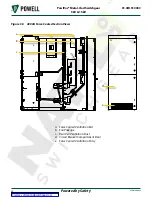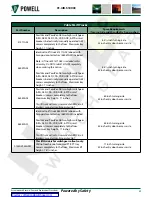
Powered by Safety
®
47
Operation
01.4IB.51000C
l. S
econDAry
D
ISconnect
D
evIce
The switchgear has a secondary disconnect
device, which is a 16-point plug mounted
at the lower end of an umbilical cord, which
hangs at the right side of the compartment.
The secondary disconnect plug (Figure 4, j)
plugs into the secondary disconnect receptacle
(Figure 5, m) on the lower right front of the
circuit breaker.
Interlocks are provided to deter misoperation
of the circuit breaker. Interlocks function as
follows:
1. The secondary disconnect plug must be
inserted into the secondary disconnect
receptacle when the circuit breaker is in
the disconnect position in order to rack the
circuit breaker from the test position.
2. The secondary disconnect plug must be
inserted into the secondary disconnect
receptacle to operate the circuit breaker in
the test position.
3. The secondary disconnect plug may be
withdrawn with the circuit breaker in the
test position, by depressing the secondary
disconnect guide, which holds the plug
in place, and pulling straight out on the
plug’s handle to disconnect the secondary
disconnect plug. The circuit breaker cannot
be operated or racked in either direction
with the plug withdrawn. Removing the
plug will open a closed circuit breaker and
discharge the closing spring if it is charged.
4. The secondary disconnect devices must be
completed to enable the act of racking the
circuit breaker between the test position
and the connected position. During this
act, the plug is held captive and cannot be
withdrawn until the circuit breaker returns
to the test position.
Figure 36 Lower Mechanism-Operated Cell
Switch (MOC) and Operating
Mechanism
a. Mechanism-Operated Cell Switch (MOC)
b. MOC Operating Linkage
c. Cam Plate
d. Shutter Operating Cam Plate
e. Pivoted MOC Operating Angle
f. Bolted-On Angle
a
b
c
d
e
f














































